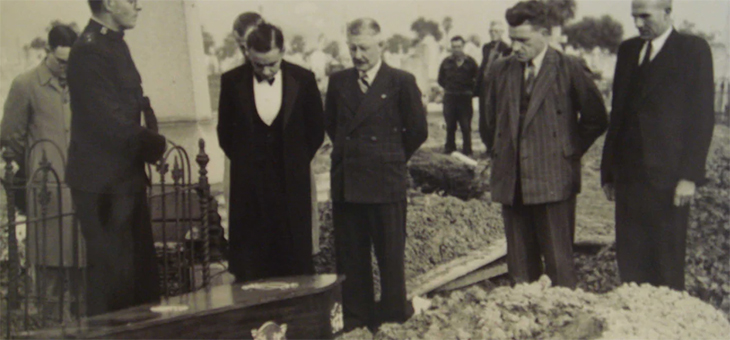The highly anticipated exhumation of the remains of the mysterious Somerton Man will be carried out today – the first step towards potentially developing a DNA profile and cracking the decades-long cold case.
Police have revealed that work to unearth the man’s remains from his resting place in Adelaide’s West Terrace Cemetery – beneath a headstone that refers to him simply as “the unknown man” – will begin about 8:00am.
The exhumation could be the first step in a potentially lengthy process, but there are unanswered questions about the condition of the man’s body and whether DNA can be retrieved.
The identity and cause of death of the Somerton Man have remained a mystery ever since his body was spotted by passers-by, slumped against the seawall, at Somerton Beach on December 1, 1948.
The case has sparked speculation that he was a spy or the forlorn lover of an enigmatic woman known as Jestyn, who lived not far from where his body was found.
A coronial inquest left the case unsolved, and interest in it has grown significantly over the past 73 years, with internet blogs now maintained by cipher enthusiasts and amateur sleuths.
Last month, SA Police revealed that Attorney-General Vickie Chapman had approved an exhumation order on the grounds that the case had generated “intense public interest”.
“It’s an enduring mystery – but I believe that, finally, we may uncover some answers, thanks to the combined expertise of SA Police and [Forensic Science SA],” Ms Chapman said.
SA Police’s Major Crime Investigation Branch remains in charge of the case, which is now part of Operation Persevere looking into all unidentified human remains.
Detective Superintendent Des Bray said that once the man’s body was exhumed, Forensic Science SA would try to recover a DNA profile.
“If a DNA profile can be obtained … a forensic case meeting will be held to formulate the most appropriate DNA strategy which will then require considerable investigation work to have any chance of identifying the man or where he originated from,” he said.
A previous request to have the man’s remains exhumed was denied but Forensic Science SA assistant director of operations Anne Coxon said an exhumation was now considered worthwhile.
She said that was because the available technology is “light years ahead of the techniques available when this body was discovered in the late 1940s”.
“Tests of this nature are often highly complex and will take time, however we will be using every method at our disposal to try and bring closure to this enduring mystery,” she said.
The case is regarded as particularly baffling because of the number of clues, including a possible coded message and a scrap of paper with the Persian words “Tamam Shud”, meaning “it is finished”, ripped from the poetry book The Rubaiyat of Omar Khayyam.
“Keane” and “Kean” were the only words found on items in a suitcase believed to belong to the Somerton Man, but other pieces of clothing had their tags removed.
Before the Somerton Man was buried in June 1949, he was embalmed using formaldehyde to preserve his body – but there are fears that process could have destroyed much of his DNA.
Researcher Derek Abbott – who believes his wife Rachel could be a descendant of the man – remains cautious about the prospects of exhumation leading to identification.
“Who knows what the condition is – if roots have gone through it, it could be in very poor condition but at least it hasn’t visibly sunken like some of the other graves,” he said.
“The man is buried on top of two other people from a previous century. When your lease runs out, the cemetery authority can bury somebody on top of you, and that’s what happened.
“One would hope that the bones of all three haven’t got mixed up and there’s sufficient separation between all three, but who knows?”
Professor Abbott also said finding a match would be difficult, and that researchers may need as many as 800,000 DNA markers.
“All you’re doing is finding relatives through the DNA,” he said.
“Once you find those relatives, the idea is you can look at their family trees, and triangulate their family trees and find a stop somewhere that’s a bloke missing in 1948. That’s your man.”
 © 2020 Australian Broadcasting Corporation. All rights reserved.
© 2020 Australian Broadcasting Corporation. All rights reserved.
ABC Content Disclaimer

